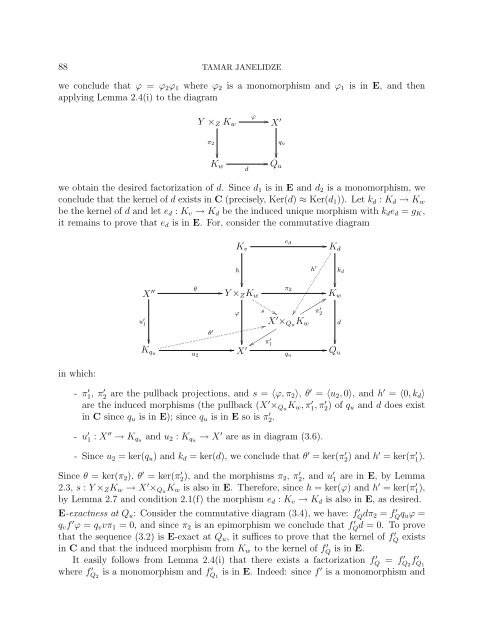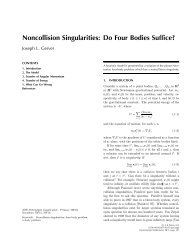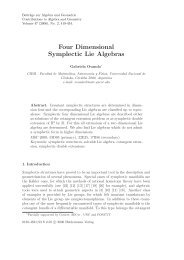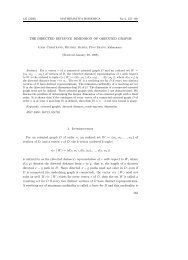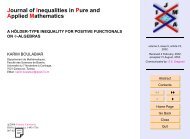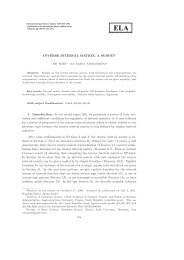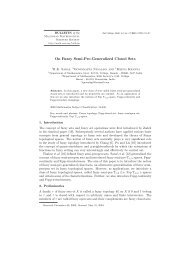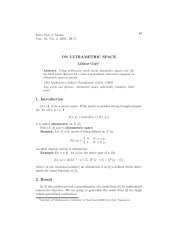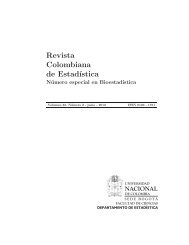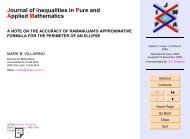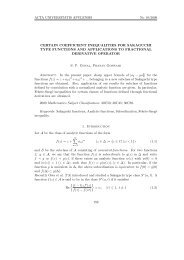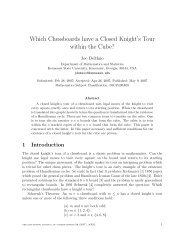SNAKE LEMMA IN INCOMPLETE RELATIVE HOMOLOGICAL ...
SNAKE LEMMA IN INCOMPLETE RELATIVE HOMOLOGICAL ...
SNAKE LEMMA IN INCOMPLETE RELATIVE HOMOLOGICAL ...
You also want an ePaper? Increase the reach of your titles
YUMPU automatically turns print PDFs into web optimized ePapers that Google loves.
88 TAMAR JANELIDZE<br />
we conclude that ϕ = ϕ 2 ϕ 1 where ϕ 2 is a monomorphism and ϕ 1 is in E, and then<br />
applying Lemma 2.4(i) to the diagram<br />
Y × Z K w<br />
ϕ<br />
X ′ q u<br />
π 2<br />
<br />
K w<br />
d<br />
Q u<br />
we obtain the desired factorization of d. Since d 1 is in E and d 2 is a monomorphism, we<br />
conclude that the kernel of d exists in C (precisely, Ker(d) ≈ Ker(d 1 )). Let k d : K d → K w<br />
be the kernel of d and let e d : K v → K d be the induced unique morphism with k d e d = g K ,<br />
it remains to prove that e d is in E. For, consider the commutative diagram<br />
K v<br />
e d<br />
K d<br />
h<br />
h ′<br />
k d<br />
X ′′ θ Y × Z K w<br />
ϕ<br />
u ′ 1<br />
θ ′<br />
π 2<br />
K w<br />
s <br />
X ′ × Qu K w d<br />
π 2<br />
′<br />
π 1<br />
′<br />
K qu<br />
<br />
u2 X ′ <br />
q u<br />
Q u<br />
in which:<br />
- π ′ 1, π ′ 2 are the pullback projections, and s = 〈ϕ, π 2 〉, θ ′ = 〈u 2 , 0〉, and h ′ = 〈0, k d 〉<br />
are the induced morphisms (the pullback (X ′ × Qu K w , π ′ 1, π ′ 2) of q u and d does exist<br />
in C since q u is in E); since q u is in E so is π ′ 2.<br />
- u ′ 1 : X ′′ → K qu and u 2 : K qu → X ′ are as in diagram (3.6).<br />
- Since u 2 = ker(q u ) and k d = ker(d), we conclude that θ ′ = ker(π ′ 2) and h ′ = ker(π ′ 1).<br />
Since θ = ker(π 2 ), θ ′ = ker(π ′ 2), and the morphisms π 2 , π ′ 2, and u ′ 1 are in E, by Lemma<br />
2.3, s : Y × Z K w → X ′ × Qu K w is also in E. Therefore, since h = ker(ϕ) and h ′ = ker(π ′ 1),<br />
by Lemma 2.7 and condition 2.1(f) the morphism e d : K v → K d is also in E, as desired.<br />
E-exactness at Q u : Consider the commutative diagram (3.4), we have: f Q ′ dπ 2 = f Q ′ q uϕ =<br />
q v f ′ ϕ = q v vπ 1 = 0, and since π 2 is an epimorphism we conclude that f Q ′ d = 0. To prove<br />
that the sequence (3.2) is E-exact at Q u , it suffices to prove that the kernel of f Q ′ exists<br />
in C and that the induced morphism from K w to the kernel of f Q ′ is in E.<br />
It easily follows from Lemma 2.4(i) that there exists a factorization f Q ′ = f Q ′ 2<br />
f Q ′ 1<br />
where f Q ′ 2<br />
is a monomorphism and f Q ′ 1<br />
is in E. Indeed: since f ′ is a monomorphism and


